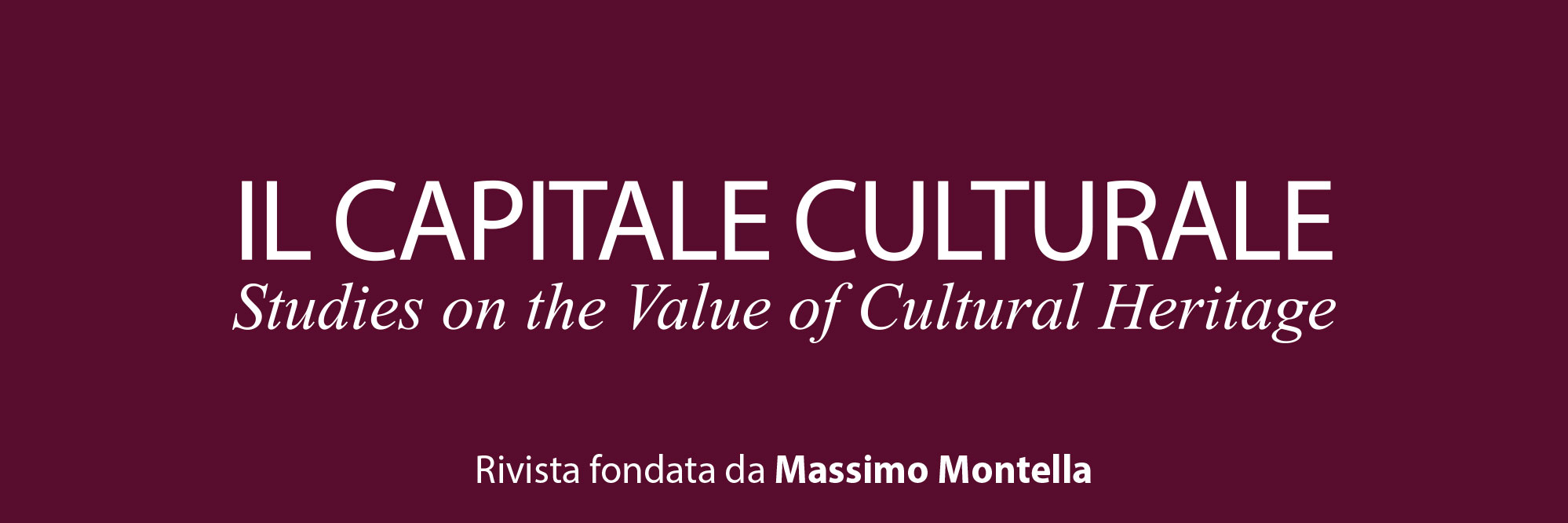Stone or Sound. Memory and Monuments in Contemporary Public Art
Downloads
Pubblicato
Fascicolo
Sezione
Licenza
Tutti i materiali pubblicati sono coperti da copyright, mantenuto dall'Università di Macerata che ne supporta finanziariamente e tecnicamente la pubblicazione.
La licenza adottata è la Creative Commons - Attribuzione/Condividi allo stesso modo. Ovvero, gli autori che pubblicano su questa rivista accettano le seguenti condizioni:
- Gli autori mantengono i diritti sulla loro opera e cedono alla rivista il diritto di prima pubblicazione dell'opera, contemporaneamente licenziata sotto una Licenza Creative Commons - Attribuzione che permette ad altri di condividere l'opera indicando la paternità intellettuale e la prima pubblicazione su questa rivista.
- Gli autori possono aderire ad altri accordi di licenza non esclusiva per la distribuzione della versione dell'opera pubblicata (es. depositarla in un archivio istituzionale o pubblicarla in una monografia), a patto di indicare che la prima pubblicazione è avvenuta su questa rivista.
- Gli autori possono diffondere la loro opera online (es. in repository istituzionali o nel loro sito web) prima e durante il processo di submission, poiché può portare a scambi produttivi e aumentare le citazioni dell'opera pubblicata.
DOI:
https://doi.org/10.13138/2039-2362/1200Abstract
Abstract
This essay tackles the issue whether contemporary monuments can still provide plausible supports for memory, even when they undermine the traditional forms of commemoration and are labeled as “anti-monuments” or “counter-monuments”. A starting point has been detected in the experiences of the 1960s, when the monumental tradition started to loose its essential self-referentiality, and artistic production with memorial aims challenged traditional boundaries and lost its traditional frame characterized by stability, universality and rhetoric. In this period, related theoretical efforts were made to grasp the ongoing change and to understand the relationship between "document" and "monument" and viceversa as connected with the interpretation of history and its manipulation. It was, however, the discussion, developing from the late 1980s and early 1990s about Public art (as an evolution from "site specificity" to art for the public place, and public interest) that involved also the status of monuments as technical hybrids extending across disciplines and artifacts, sometimes contingent and perishable, but which nevertheless fulfil both a documentary and an artistic function. Thus, examples of recent relevant exhibitions and specific monuments have been selected that are supposed to be a memorial in relationship with contemporary public art, where collective and individual experiences basically intersect. They are all artworks that implement the criticism of traditional monuments and attempt to provide alternatives involving different audiences and moving between opposites as presence and absence, persistence and temporality materiality and immateriality. And yet, in post-monumental times monuments persist (in sound or stone) if they can embody historical contingency.
In questo saggio si affronta la nozione di monumento nel mondo contemporaneo a partire dalla domanda se essi possano ancora fungere da supporti plausibili per la memoria anche quando, etichettati come "anti-monumenti" o "contro-monumenti", minano le forme tradizionali della commemorazione. Negli anni Sessanta la tradizione monumentale ha iniziato a perdere la sua essenziale autoreferenzialità a seguito di molta produzione artistica che, pur con finalità commemorative, è andata, anche negli anni Settanta, oltre i confini della stabilità, universalità e della retorica. Nello stesso periodo è riconoscibile anche il sorgere di sforzi teorici volti a cogliere il cambiamento in atto, soprattutto in merito al rapporto tra "documento" e "monumento". È stato, tuttavia, lo sviluppo fra anni ‘80 e ‘90 dell'arte pubblica (dall’opera site specific a un’arte per e nell'interesse pubblico), che ha coinvolto anche lo statuto dei monumenti intesi come ibridi trans-disciplinari e artefatti, talvolta contingenti e deperibili, aventi tuttavia funzione documentaria e artistica. Sono stati, quindi, selezionati esempi di rilevanti mostre recenti e di casi specifici di monumenti/memoriali, nell’ambito dell’arte pubblica contemporanea, dove le esperienze collettive e individuali finiscono per intersecarsi. Si tratta di opere che implementano la critica dei monumenti tradizionali e cercano di fornire alternative coinvolgendo diversi tipi di pubblico. In epoca post-monumentale tali esempi si muovono tra poli opposti, come presenza e assenza, persistenza e temporalità, materialità e immaterialità e dimostrano quanto, nonostante tutto, si possa parlare ancora di monumenti ogni qualvolta l’intervento artistico riesca a cogliere ed incarnare, in qualunque forma e materia, la contingenza storica.
Riferimenti bibliografici
Allen J. (2010), History and Trauma/Geschiedenis en Trauma, in Monumentalism – History, National Identity and Contemporary Art / Monumentalisme – Geschiedenis, nationale Identiteit en hedendaagse Kunst, edited by/onder redactie van J. Bouwhuis, M. Schavemaker, Stedelijk Museum Amsterdam, Rotterdam: NAi Uitgevers, pp. 139-165.
Amaya M. (1985), Land Reform. New Monuments by Michael Heizer, «Studio International», 198, n. 1009, pp. 19-21.
Birnbaum D., Volz J., a cura di (2009), Fare Mondi/Making Worlds. 53° Esposizione Internazionale d’Arte, La Biennale di Venezia, catalogo della mostra, Venezia: Marsilio editore.
Böhringer H. (2007), Monument, in Sculpture Project Münster 07, edited by B. Franzen, K. König, C. Plath, Köln: Verlag der Buchhandlung Walther König, pp. 398-399.
Bourriaud N. (1998), Esthètique relationelle, Paris: Les presses du réel.
Bouwhuis J., Schavemaker M., edited by/ onder redactie van (2010), Monumentalism – History, National Identity and Contemporary Art / Monumentalisme – Geschiedenis, nationale Identiteit en hedendaagse Kunst, Stedelijk Museum Amsterdam, Rotterdam: NAi Uitgevers.
Burnham J.W. (1967a), Beyond Modern Sculpture, New York: George Braziller.
Burnham J.W. (1967b), Sculpture’s Vanishing Base, «Artforum», VI, n. 3, pp. 47-55.
Carpenter J. (1983), Alan Sonfi st’s Public Sculptures, in Sonfi st 1983, pp. 142-154.
Carrier P. (2000), Monuments and national memory cultures in France and Germany since 1989: the “Vél d’Hiv” in Paris and the Holocaust Monument in Berlin, Berlin: Freie University, Diss. (http://webdoc.sub.gwdg.de/ebook/diss/2003/fu-berlin/2002, 12.07.2015).
Cavallucci F. (2010a), Monumenti e rovine/ Monuments and Ruins, in Postmonument, a cura di/ curated by F. Cavallucci, Cinisello Balsamo: Silvana Editoriale, pp. 12-19.
Cavallucci F., a cura di/ edited by (2010b), Postmonument, Cinisello Balsamo: Silvana Editoriale.
Celant G. (2007), Nel territorio di Piero Manzoni, in Manzoni, a cura di G. Celant, Milano: Electa, pp. 14-45.
Didi-Huberman G. (2000), Devant le temps. Historie de l’art et anachronisme des images, Paris: Edition de Minuit.
Ferriani B., Pugliese M., a cura di (2009), Monumenti effi meri. Storia e conservazione delle installazioni, Milano: Electa.
Foucault M. (1969), L’archéologie du savoir, Paris: nrf Editions Gallimard.
Gallo F. (2012), Appunti sull’immemoriale. Tra crisi del monumento e ‘memory boom’, in Volti della memoria, a cura di G. Di Giacomo, Milano-Udine: Mimesis Edizioni, pp. 277-291.
Griswold C.L. (1990), The Vietnam Veterans Memoria and the Washington Mall: Philosophical Toughts on Political Iconography, in Art and the Public Sphere, edited by W.J.T. Mitchell, Chicago & London: The University of Chicago Press, pp. 79-112.
Hall C. (1983), Environmental Artists: Sources and Directions, in Sonfi st 1983, pp. 8-59.
Hein H. (2006), Public Art. Thinking Museums Differently, New York, Toronto, Oxford, Lanham: Altamira Press.
Krauss R. (1979), Sculpture in the Expanded Field, «October», n. 8, spring, pp. 30-44, also in The Originality of Avant-Garde and Other Modernist Myths, Cambridge Mass.: MIT Press, 1985.
Kultermann U. (1967), Neue Dimensionen der Plastik, Tubingen: Wasmuth.
Lacy S., edited by (1995), Mapping the Terrain, New Genre of Public Art, Seattle: Bay Press.
Leerssen J. (2010), Size, Seriousness and the Sublime/ Groots, grimmig geheugen, in Bouwhuis, Schavemaker 2010, pp. 117-137.
Le Goff J. (1978), Documento/Monumento, in Enciclopedia Einaudi, vol. V, Torino: Einaudi, pp. 38-43.
Mancini M.G. (2011), L’arte nello spazio pubblico. Una prospettiva critica, Salerno: Plectica editrice.
Marchard O. (2007), Public Art, in Sculpture Project Münster 07, edited by B. Franzen, K. König, C. Plath, Köln: Verlag der Buchhandlung Walther König, p. 426.
Marten C., edited by (2012), Documenta (13). Das Begeleitbuch/ The Guidebook, Katalog/Catalogue 3/3, Ostfi ldern: Hatje Cantz.
Miles M. (1997), Art, Space and the City. Public Art and Urban Futures, London & New York: Routledge.
Natalicchio C. (2010), Crisi economica e Postmonumenti / Economic Crisis and PostMonuments (intervista a / interview with Zygmunt Bauman), in Cavallucci 2010, pp. 22-23.
Pinotti A. (2010), Doppelgänger. Il monumento e il suo doppio, in Quando è scultura, a cura di C. Baldacci, C. Ricci, Milano: et al. edizioni, pp. 34-43. Pioselli A. (2007), Arte e scena urbana. Modelli di intervento e politiche culturali pubbliche in Italia fra il 1968 e il 1981, in L’arte pubblica nello spazio urbano. Committenti, artisti, fruitori, a cura di C. Birrozzi, M. Pugliese, Milano: Mondadori, pp. 20-38.
Reinink W., Stumpel J., edited by (1999), Memory & Oblivion. Proceedings of the XXIXth International Congress of the History of Art (Amsterdam, 1-7 September 1999), Berlin/Dordrecht: Springer.
Ricci C. (2010), “Qui ed ora” come dispositivo temporale, in Quando è scultura, a cura di C. Baldacci, C. Ricci, Milano: et al. edizioni, pp. 71-82.
Rose J. (2012), Objects in the Cluttered Field: Claes Oldenburg’s Proposed Monuments, «October», n. 140, Spring, pp. 113-138.
Siegel P. (2005), Zeitgenössische Denkmal Konzepte in Deutschland, Goethe Institut, http://www.goethe.de/kue/arc/dos/dos/zdk/en204638.htm, 12.07.2015.
Smithson R. (1966), Entropy and the New Monuments, in The Writings of Robert Smithson, edited by N. Holt, New York: New York University Press, pp. 9-18.
Sonfist A., edited by (1983), Art in the Land. A Critical Anthology of Environmental Art, New York: E.P. Dutton.
Summers D. (2003), Real Spaces. World Art History and the Rise of Western Modernism, London-New York: Phaidon Press.
Tedeschi F. (2011), Oltre il monumento. La scultura urbana e il problema della collocazione di opere d’arte nello spazio pubblico, in Paesaggio con figura. Arte, sfera pubblica, trasformazione sociale, a cura di G. Scardi, Torino: Umberto Allemandi & C., pp. 53-67.
Unmonumental. The Object in the 21th Century (2007), New York: Phaidon Press.
Wajcman G. (2010), Un monumento invisibile, in Quando è scultura, a cura di C. Baldacci, C. Ricci, Milano: et al. edizioni, pp. 44-56.
Young J.E. (1990), The Counter-Monument: Memory against Itself in Germany Today, in Art and the Public Sphere, edited by W.J.T. Mitchell, Chicago & London: The University of Chicago Press, pp. 49-78.
Young J.E. (1992), The Counter-Monument. Memory against Itself in Germany Today, «Critical Inquiry», 18, n. 2, pp. 267-296.
Young J.E. (1999), Memory and Counter-Memory. The End of the Monument in Germany, «Harvard Design Magazine», n. 9, pp. 1-10.




